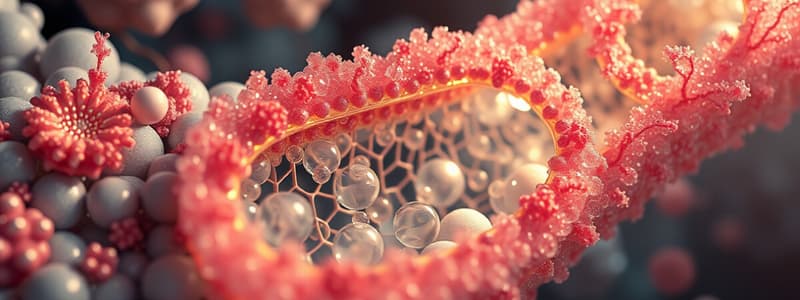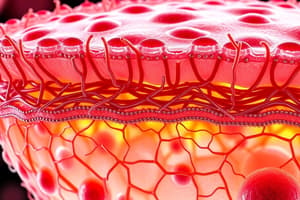Podcast
Questions and Answers
Describe the structure and components of eukaryotic membranes.
Describe the structure and components of eukaryotic membranes.
The eukaryotic plasma membrane is a phospholipid bilayer with proteins and cholesterol embedded in it.
Unlike prokaryotic cells, eukaryotic cells have:
Unlike prokaryotic cells, eukaryotic cells have:
A membrane-bound nucleus and numerous membrane-bound organelles.
Describe the general functions of the eukaryotic plasma membrane.
Describe the general functions of the eukaryotic plasma membrane.
The plasma membrane regulates the concentration of substances that can permeate a cell.
What does hypertonic mean?
What does hypertonic mean?
What does hypotonic mean?
What does hypotonic mean?
What does isotonic mean?
What does isotonic mean?
Relate the 'fluid mosaic model' to membrane structure and function.
Relate the 'fluid mosaic model' to membrane structure and function.
Explain how the plasma membrane structure provides selective permeability.
Explain how the plasma membrane structure provides selective permeability.
How does cholesterol contribute to the membrane?
How does cholesterol contribute to the membrane?
What is the main function of the plasma membrane?
What is the main function of the plasma membrane?
Describe how each membrane component contributes to the function of the eukaryotic membrane.
Describe how each membrane component contributes to the function of the eukaryotic membrane.
What are integral membrane proteins?
What are integral membrane proteins?
What are peripheral membrane proteins?
What are peripheral membrane proteins?
Describe factors affecting membrane fluidity.
Describe factors affecting membrane fluidity.
How do changes in temperature affect membrane fluidity?
How do changes in temperature affect membrane fluidity?
List and describe key roles/functions of membrane proteins.
List and describe key roles/functions of membrane proteins.
Compare and contrast passive and active transport across eukaryotic membranes.
Compare and contrast passive and active transport across eukaryotic membranes.
Describe exocytosis and endocytosis.
Describe exocytosis and endocytosis.
Flashcards are hidden until you start studying
Study Notes
Eukaryotic Cell Membrane Structure and Components
- Eukaryotic plasma membrane consists of a phospholipid bilayer with embedded proteins and cholesterol.
- The membrane is pliable, composed of two adjacent sheets of phospholipids.
- Cholesterol enhances membrane fluidity and stability.
Unique Features of Eukaryotic Cells
- Eukaryotic cells possess a membrane-bound nucleus.
- Numerous membrane-bound organelles such as endoplasmic reticulum, Golgi apparatus, mitochondria, and chloroplasts are present.
- Typically contain several rod-shaped chromosomes.
Functions of the Eukaryotic Plasma Membrane
- Regulates substance concentration that permeates the cell.
- Maintains the internal environment through selective permeability.
Types of Solutions and Their Effects on Cells
- Hypertonic: Causes cells to shrink due to water loss.
- Hypotonic: Causes cells to swell or expand due to water influx.
- Isotonic: Cells maintain their shape and volume.
Fluid Mosaic Model
- Describes the membrane as a dynamic structure made of various molecules (phospholipids, cholesterol, and proteins).
- Movement of components is crucial for maintaining cellular integrity and acting as a barrier.
Selective Permeability of the Plasma Membrane
- The lipid bilayer controls access due to tightly packed phospholipids and a hydrophobic core.
- Allows specific molecules to enter or exit, ensuring homeostasis.
Roles of Membrane Components
- Phospholipids: Form the basic structure; possess both hydrophilic and hydrophobic properties.
- Proteins: Include integral proteins (spanning the membrane) and peripheral proteins (attached to surfaces); facilitate various functions.
- Carbohydrates: Located on cell surfaces, attached to proteins/lipids; serve as cellular markers for recognition and immune response.
- Membrane Fluidity: Affected by the structure of fatty acid tails in phospholipids; essential for membrane function.
Integral Membrane Proteins
- Integrated within the membrane with at least one hydrophobic region anchoring them to the phospholipid bilayer.
- Transmembrane proteins extend across the membrane.
Peripheral Membrane Proteins
- Located on the outside and inside surfaces of membranes; attached to integral proteins or phospholipids.
- More loosely associated, do not penetrate the hydrophobic core.
Factors Affecting Membrane Fluidity
- The fluid mosaic model ensures membrane flexibility; integral proteins and lipids allow movement.
- Excessive rigidity may cause membrane rupture, particularly with increased internal pressure.
Temperature Influence on Membrane Fluidity
- Increased temperature enhances phospholipid bilayer fluidity.
- At lower temperatures, phospholipids cluster closely, reducing fluidity due to decreased kinetic energy.
Key Roles of Membrane Proteins
- Functions include transport, signaling, cell recognition, intercellular joining, and attachment to the cytoskeleton.
Passive vs. Active Transport
- Passive transport: Movement of molecules without energy input (e.g., diffusion, facilitated diffusion).
- Active transport: Requires energy to move substances against their concentration gradient (e.g., sodium-potassium pump).
Exocytosis and Endocytosis
- Exocytosis: Process through which substances are expelled from a cell in vesicles.
- Endocytosis: Mechanism for cells to internalize substances, including nutrients and signaling molecules.
Studying That Suits You
Use AI to generate personalized quizzes and flashcards to suit your learning preferences.




